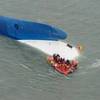Port of Rotterdam Throughput Up by 0.6%
The port of Rotterdam achieved steady results in the first half of the year. Total throughput increased by 0.6% compared to the first half of 2013. The throughput of crude oil increased by 3.3% while that of mineral oil products decreased by 13.5%. The throughput of coal grew by 9.5%, while ore throughput stayed virtually the same. Container throughput, measured in tonnes, increased by 2.7% or 1.9% when measured in TEUs.
Throughput saw a small decrease of 0.2% in the first quarter, but was slightly positive in the second quarter, causing throughput in the first half of the year to increase by 0.6%. A further recovery of the European economy is expected for the second half of the year, so that the port is on track in terms of achieving approximately 1% growth for all of 2014.
In the category liquid bulk, the throughput of crude oil has increased by 3.3%. The margins, and therefore the utilisation rates of the refineries, are still low due to the persistent low demand for refinery products in Europe and the increasing competition from refineries outside Europe, in part due to the availability of cheap shale gas in the US.
During the same period last year throughput was even lower, however, because various refineries supplied from Rotterdam at the time were partially decommissioned due to maintenance. The throughput of mineral oil products declined by 13.5%. The decline primarily concerns the outgoing throughput of products such as heating oil, naphtha and petrol. Other liquid bulk, which primarily consists of raw materials for the chemical industry, declined by 11%. Both the chemical industry and the refining sector are in a difficult position: energy and raw materials are cheaper elsewhere in the world.
The throughput of LNG increased primarily due to the increase in the re-export of LNG that is first discharged in Rotterdam.
The throughput of iron ore and scrap is stable: the European steel sector has not yet fully recovered and is running at 80% capacity. The supply of coal increased by 9.5% due to the consolidation of import flows by industrial users in the hinterland. By contrast, the demand for thermal coal remained limited due to the extremely mild winter.
In terms of dry bulk goods, agricultural bulk is the largest riser in relative terms at 37.3%. Considerably more corn was imported from the Ukraine via Rotterdam, as well as soy from South America, among other products. At the same time, there was an increase in the export of wheat. The other dry bulk goods, which among other things consist of construction materials, raw materials for industry and biomass, increased by 11.9%.
Container throughput increased by 2.7% in weight or 1.9% in terms of TEUs (standard measure for containers). This growth especially persisted from March onwards, with an average monthly growth of 4.5% in comparison to the same period in 2013. Deep sea cargo increased by 3.2% (in tonnes and TEUs) due to an increase in volumes along the east-west routes, including Asia - Rotterdam as well as North America - Rotterdam, and in the supply of containers from South America.
The feeder volume lagged the feeder volume in the first half of 2013 (-3.8% in tonnes, -4.7% TEUs) because a number of cargo packages were relocated to Hamburg at the end of June 2013. However, the feeder volume once again increased positively from the beginning of this year, not only from and to countries surrounding the Baltic Sea, but also from and to the United Kingdom as well.
The throughput of short sea containers grew by 6.1% in tonnes and 2.6% in TEUs. The growth primarily represents the transport between Rotterdam and the Baltic Sea states and Russia, and transport between Rotterdam and the United Kingdom and Ireland. A key reason for this is the improving British economy. This is also the reason for the improvement in RoRo traffic by 8.4%. There was an increase in the throughput of other general goods by 28.5% due to the increase in the demand for steel products and an increase in project cargo, particularly for the offshore industry.
The number of ocean-going vessels that visited the port in the first half of this year declined by 1.5% to 14,417. This is primarily due to the increase in scale of the container sector.
















